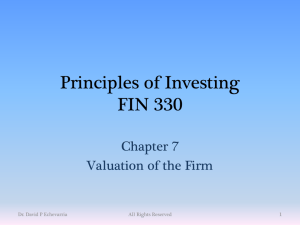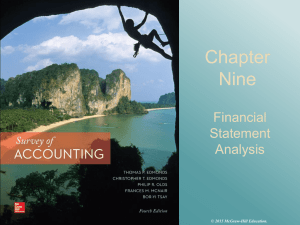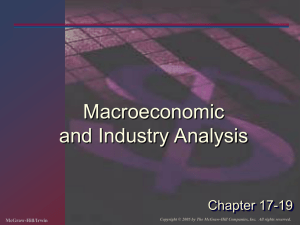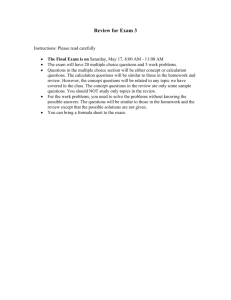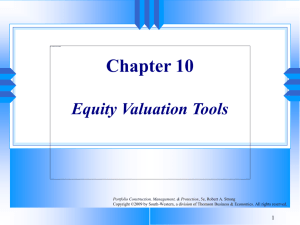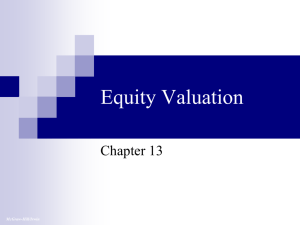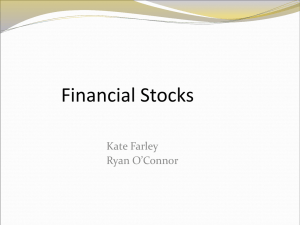Chap018 - revised
advertisement
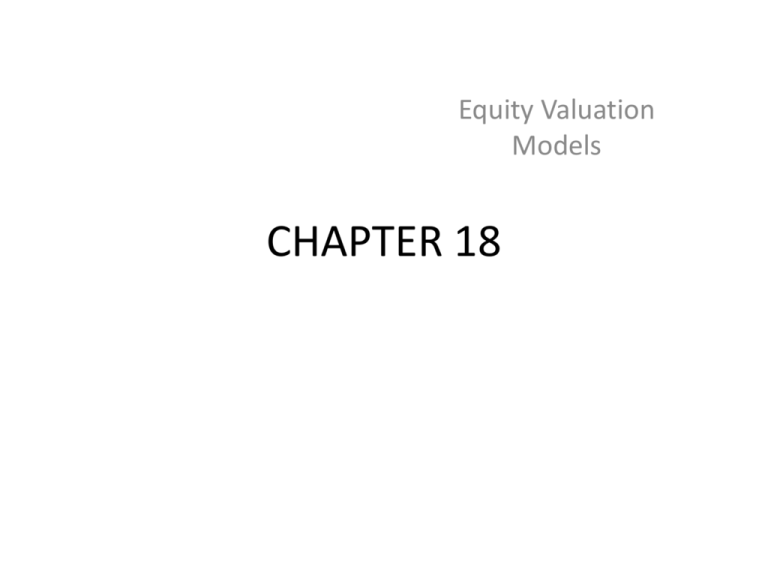
Equity Valuation Models CHAPTER 18 Valuation Methods Valuation by comparables Price/Earning Ratios Balance Sheet Models Book Value http://finance.yahoo.com/q/ks?s=CSCO http://biz.yahoo.com/ic/814.html Expected Returns vs. Required Return CAPM Intrinsic Value vs. Market price Dividend Discount Models Table 18.1 Financial Highlights for Microsoft Corporation, October 25, 2007 Limitations of Book Value • Book value is an application of arbitrary accounting rules • Can book value represent a floor value? • Better approaches – Liquidation value – Replacement cost – Tobin’s q ratio Expected Holding Period Return • The return on a stock investment comprises cash dividends and capital gains or losses – Assuming a one-year holding period Expected HPR= E (r ) E ( D1 ) E ( P1 ) P0 P0 Required Return • CAPM gave us required return: k rf E (rM ) rf • If the stock is priced correctly – Required return should equal expected return Intrinsic Value and Market Price • Intrinsic Value – Self assigned Value – Variety of models are used for estimation • Market Price – Consensus value of all potential traders • Trading Signal – IV > MP Buy – IV < MP Sell or Short Sell – IV = MP Hold or Fairly Priced Specified Holding Period D D V (1 k ) (1 k ) 1 0 2 1 P D ... (1 k ) H 2 H H PH = the expected sales price for the stock at time H H = the specified number of years the stock is expected to be held Dividend Discount Models: General Model Dt Vo t t 1 (1 k ) V0 = Value of Stock Dt = Dividend k = required return No Growth Model D Vo k • Stocks that have earnings and dividends that are expected to remain constant – Preferred Stock No Growth Model: Example D Vo k E1 = D1 = $5.00 k = .15 V0 = $5.00 /.15 = $33.33 Constant Growth Model Do(1 g ) Vo kg g = constant perpetual growth rate Constant Growth Model: Example Do (1 g ) Vo kg E1 = $5.00 b = 40% k = 15% (1-b) = 60% D1 = $3.00 g = 8% V0 = 3.00 / (.15 - .08) = $42.86 Estimating Dividend Growth Rates g ROE b g = growth rate in dividends ROE = Return on Equity for the firm b = plowback or retention percentage rate (1- dividend payout percentage rate) Figure 18.1 Dividend Growth for Two Earnings Reinvestment Policies Present Value of Growth Opportunities • If the stock price equals its IV, growth rate is sustained, the stock should sell at: D1 P0 kg • If all earnings paid out as dividends, price should be lower (assuming growth opportunities exist) Present Value of Growth Opportunities Continued • Price = No-growth value per share + PVGO (present value of growth opportunities) E1 P0 PVGO k Partitioning Value: Example ROE = 20% d = 60% b = 40% E1 = $5.00 D1 = $3.00 k = 15% g = .20 x .40 = .08 or 8% Partitioning Value: Example Continued 3 Vo $42.86 (.15.08) 5 NGVo $33.33 .15 PVGO $42.86 $33.33 $9.52 Vo = value with growth NGVo = no growth component value PVGO = Present Value of Growth Opportunities Life Cycles and Multistage Growth Models (1 g1 ) DT (1 g 2 ) P0 D0 t T (1 k ) ( k g )(1 k ) t 1 2 T t • g1 = first growth rate • g2 = second growth rate • T = number of periods of growth at g1 Multistage Growth Rate Model: Example D0 = $2.00 g1 = 20% g2 = 5% k = 15% T = 3 D1 = 2.40 D2 = 2.88 D3 = 3.46 D4 = 3.63 V0 = D1/(1.15) + D2/(1.15)2 + D3/(1.15)3 + D4 / (.15 - .05) ( (1.15)3 V0 = 2.09 + 2.18 + 2.27 + 23.86 = $30.40 Table 18.2 Financial Ratios in Two Industries Figure 18.2 Value Line Investment Survey Report on Honda Motor Co. Price Earnings Ratios • P/E Ratios are a function of two factors – Required Rates of Return (k) – Expected growth in Dividends • Uses – Relative valuation – Extensive Use in industry P/E Ratio: No Expected Growth E1 P0 k P0 1 E1 k • E1 - expected earnings for next year – E1 is equal to D1 under no growth • k - required rate of return P/E Ratio: Constant Growth D1 E1 (1 b) P0 k g k (b ROE ) P0 1 b E1 k (b ROE ) b = retention ratio ROE = Return on Equity Numerical Example: No Growth E0 = $2.50 g = 0 k = 12.5% P0 = D/k = $2.50/.125 = $20.00 PE = 1/k = 1/.125 = 8 Numerical Example: Growth b = 60% ROE = 15% (1-b) = 40% E1 = $2.50 (1 + (.6)(.15)) = $2.73 D1 = $2.73 (1-.6) = $1.09 k = 12.5% g = 9% P0 = 1.09/(.125-.09) = $31.14 PE = 31.14/2.73 = 11.4 PE = (1 - .60) / (.125 - .09) = 11.4 Table 18.3 Effect of ROE and Plowback on Growth and the P/E Ratio P/E Ratios and Stock Risk • Holding all else equal – Riskier stocks will have lower P/E multiples – Higher values of k; therefore, the P/E multiple will be lower P 1 b E kg Pitfalls in P/E Analysis • Use of accounting earnings – Earnings Management – Choices on GAAP • Inflation • Reported earnings fluctuate around the business cycle Figure 18.3 P/E Ratios of the S&P 500 Index and Inflation Figure 18.4 Earnings Growth for Two Companies Figure 18.5 Price-Earnings Ratios Figure 18.6 P/E Ratios for Different Industries, 2007 Other Comparative Value Approaches • Price-to-book ratio • Price-to-cash-flow ratio • Price-to-sales ratio Figure 18.7 Market Valuation Statistics Free Cash Flow Approach • Discount the free cash flow for the firm • Discount rate is the firm’s cost of capital • Components of free cash flow – After tax EBIT – Depreciation – Capital expenditures – Increase in net working capital Comparing the Valuation Models • In practice – Values from these models may differ – Analysts are always forced to make simplifying assumptions The Aggregate Stock Market • Explaining Past Behavior • Forecasting the Stock Market Figure 18.8 Earnings Yield of S&P 500 versus 10-Year Treasury-Bond Yield Table 18.4 S&P 500 Price Forecasts Under Various Scenarios



